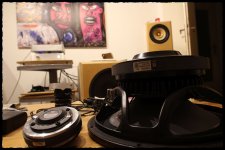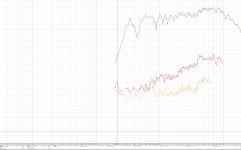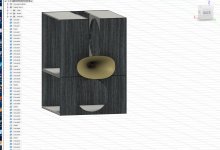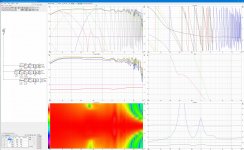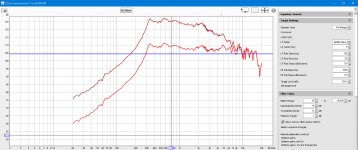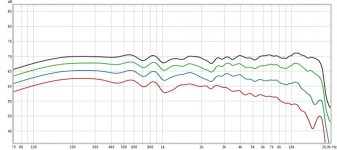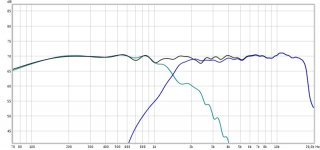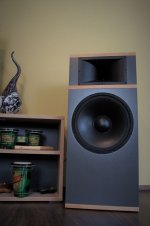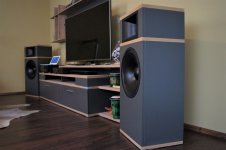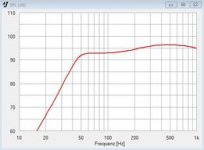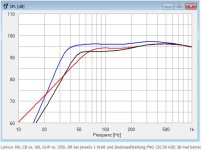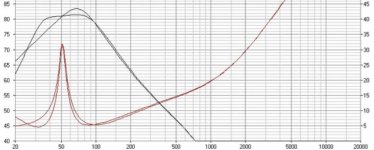theres a post somewhere on the internet with several compression drivers compared...
Impedance and spectral decay were shown and i think some older jbl Be drivers were in the mix....I'd love to compare my measurements... of course can't find it now...anyone got a link to any measurements I might compare?
camplo,
are you looking for the document "Horns_measurements_ETF2010d " ?
http://forums.melaudia.net/attachment.php?aid=1760
- bodo
I'm not sure what "on wall" means...
shallow wall-mounted enclosures, like tweeters modules in old McIntosh XRT20, XRT16, XRT22
Today my first (a used) 18 sound 12 inch model arrived, a spherical wave horn with a 1 inch BMS [4538] driver is planned.
Due to the coronavirus I will unfortunately not be able to cut wood until mid-February
Due to the coronavirus I will unfortunately not be able to cut wood until mid-February
Attachments
Last edited:
Crazy right? I just left my local Grainger, who apparently closes at 4 instead of 5...likely corona related...I’ll be back tomorrow..I’ve decided that no matter what, the subwoofer is going to be difficult...so why not satisfy myself and at least give the bracing a running chance to deal with the 18” backwave at a 12” depth...I already planned on joining the woofers with threaded rod...so extending the rods from one side of the cabinets all the way to the other side would but a bracing pattern surrounding the woofer output at the back wall of each woofer. Might be overkill but it is simple.
Hmm, as quick as it goes to the site, it disconnects even quicker, though this one works for me: http://mariobon.com/Articoli_storici/Horns_measurements_ETF2010d.pdf
Thanks for the links guys, I know there's another one out there where the focus was on showing the relation of resonances, or as I like to call it...decay (since all sound is a form of resonanation)....to sound quality. I think every here acknowledges this already so no big deal right?
The measurements at the mouth are the most intimate, no? so if any resonances were to be recorded, this is a great place to inspect, correct? The measurements look pretty good to me...I did not see any one make a comment so I guess I will speak on it. The spectral decay being comparable if not better than the SM75-150....I get excited.
I have not really gotten intimate with the combo, but I do believe I have found the xmax or close to it....this is why I posted the quote about titanium the other day, lol...and no I did not here any clacky sounds....the sweeps were done with kid noise in the back ground, I don't know if that would throw my thd readings off but...
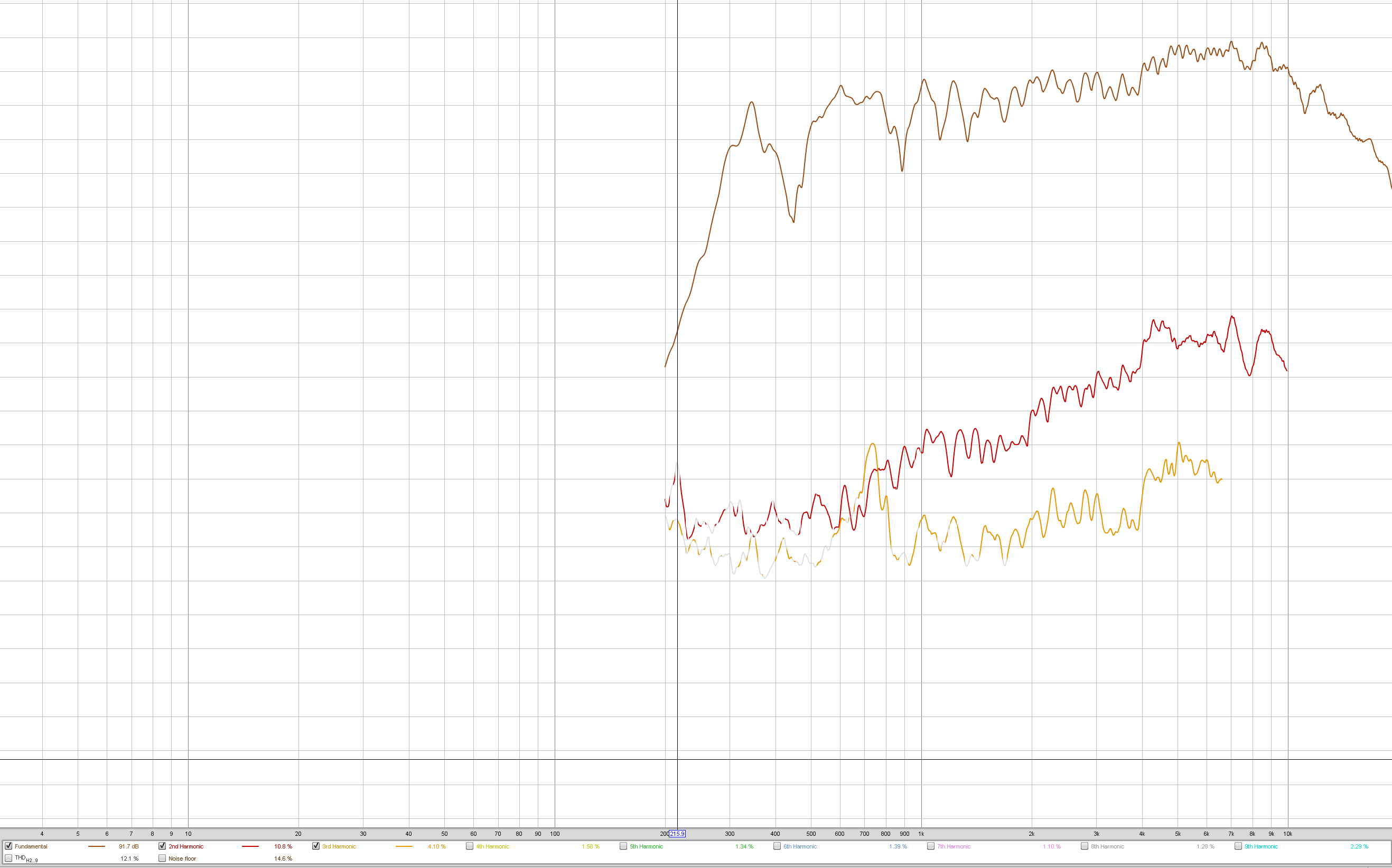
Thats at ~ 1meter (with eq), I was holding the mic lol, but I did measure the distance...Funny story about the voicing...I don't recall measuring without eq at 1 meter, so the (uneq'd) curve is actually a lot closer to flat at 1 meter...which describes why what I was hearing sound so flat.....yet the measurements at the mouth...I'm sure you get it...thats definitely a rookie mistake, laugh at my expense 🙄...So my first attempt at eq, i let REW do to its thing just see what would happen...but that was a no go...but eqing it the way I would of thought first .....with one low pass shelf... I can pretty much get it going in the right direction...
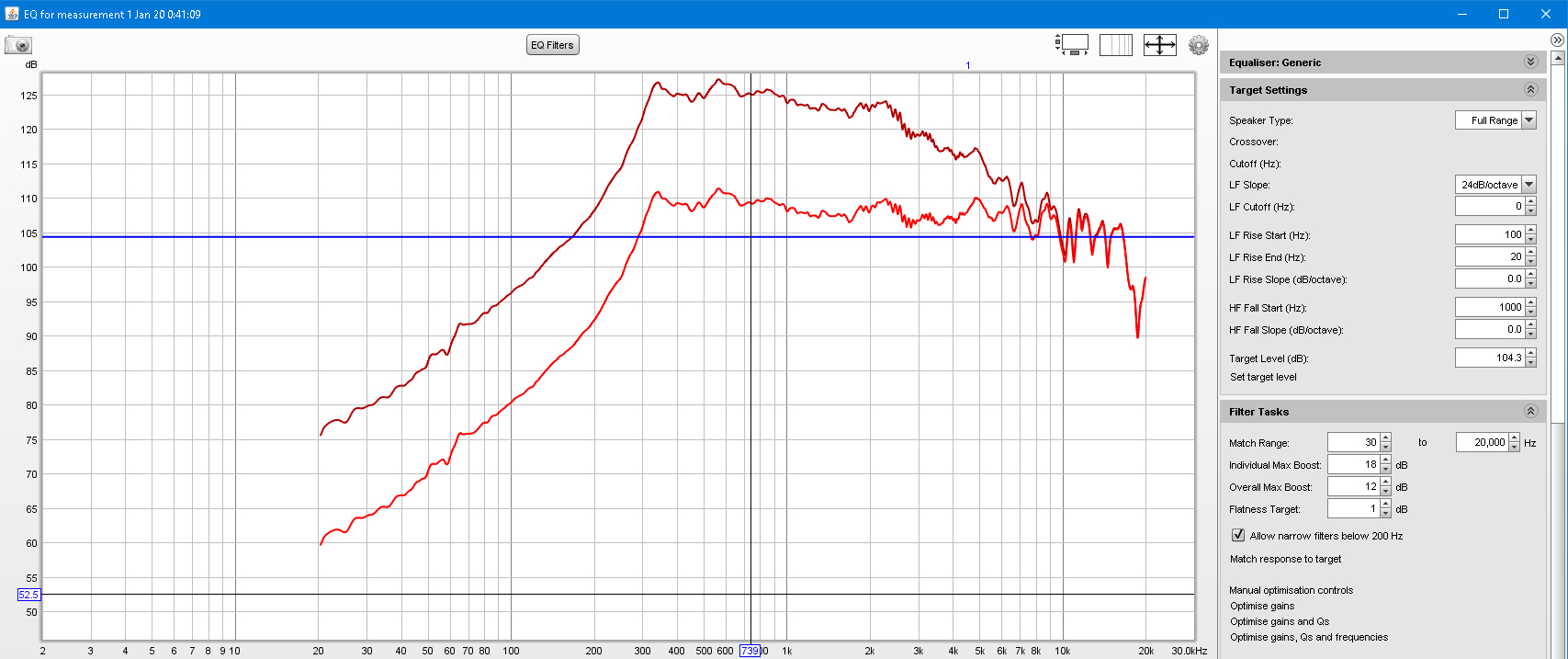 the measurement above (first pic) had just one low pass shelf, with about 9db of attenuation....which is too much...if it turns out flat at one meter with no eq I'm going too be happy but also facepalm...also the dips in the response are from the ceiling again....itis just not convenient to take measurements here lol! It will be more conducive when I get everything set up.
the measurement above (first pic) had just one low pass shelf, with about 9db of attenuation....which is too much...if it turns out flat at one meter with no eq I'm going too be happy but also facepalm...also the dips in the response are from the ceiling again....itis just not convenient to take measurements here lol! It will be more conducive when I get everything set up.
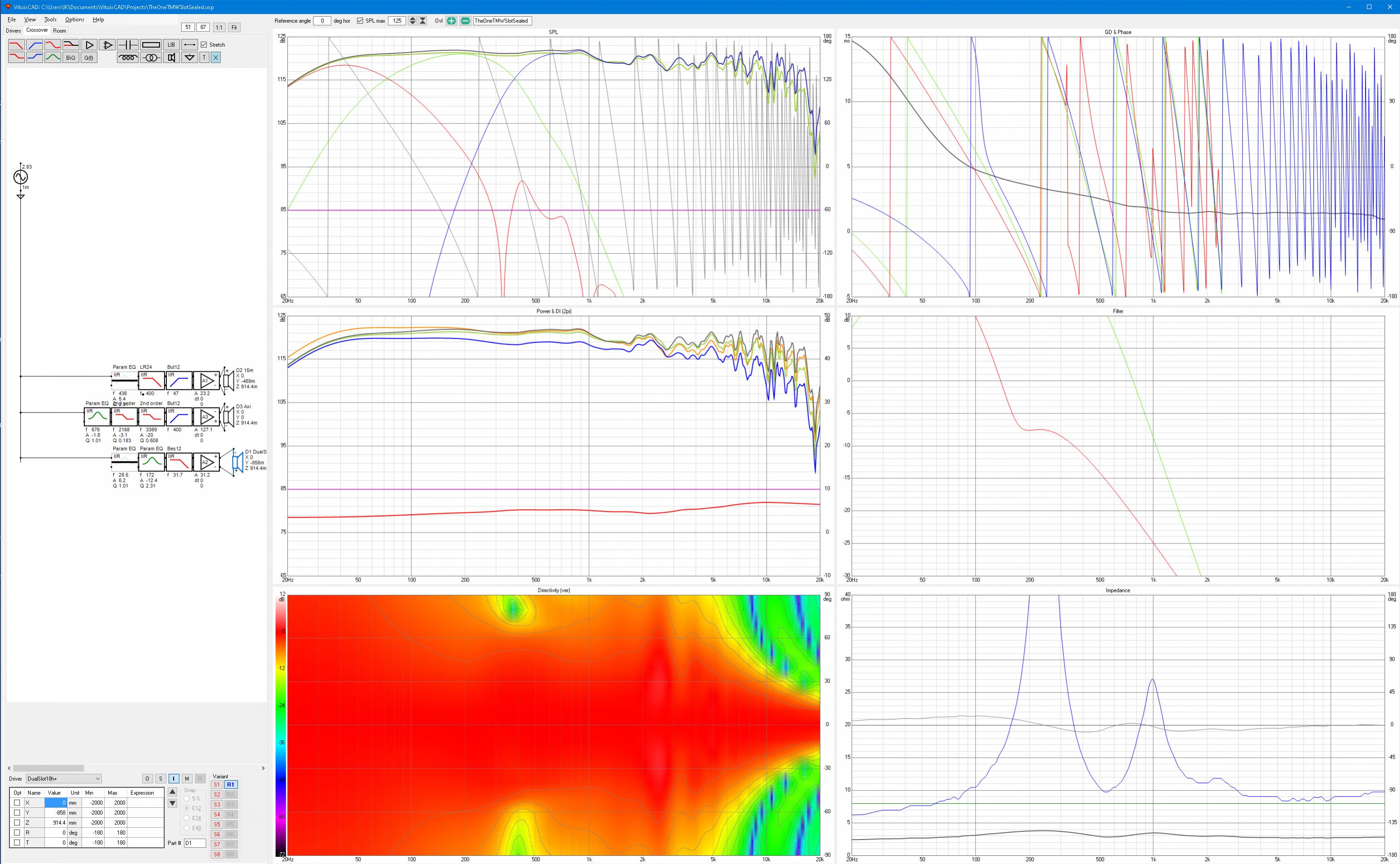
I made a crappy model of the horn again, but closer to the real thing, this time I used a 2" source with a baffle that was the rectangle size of my horn....so theoretically speaking my horn, in real life, might have some similar polar? probably not close at all but better than the last model lol!!
Finally does this
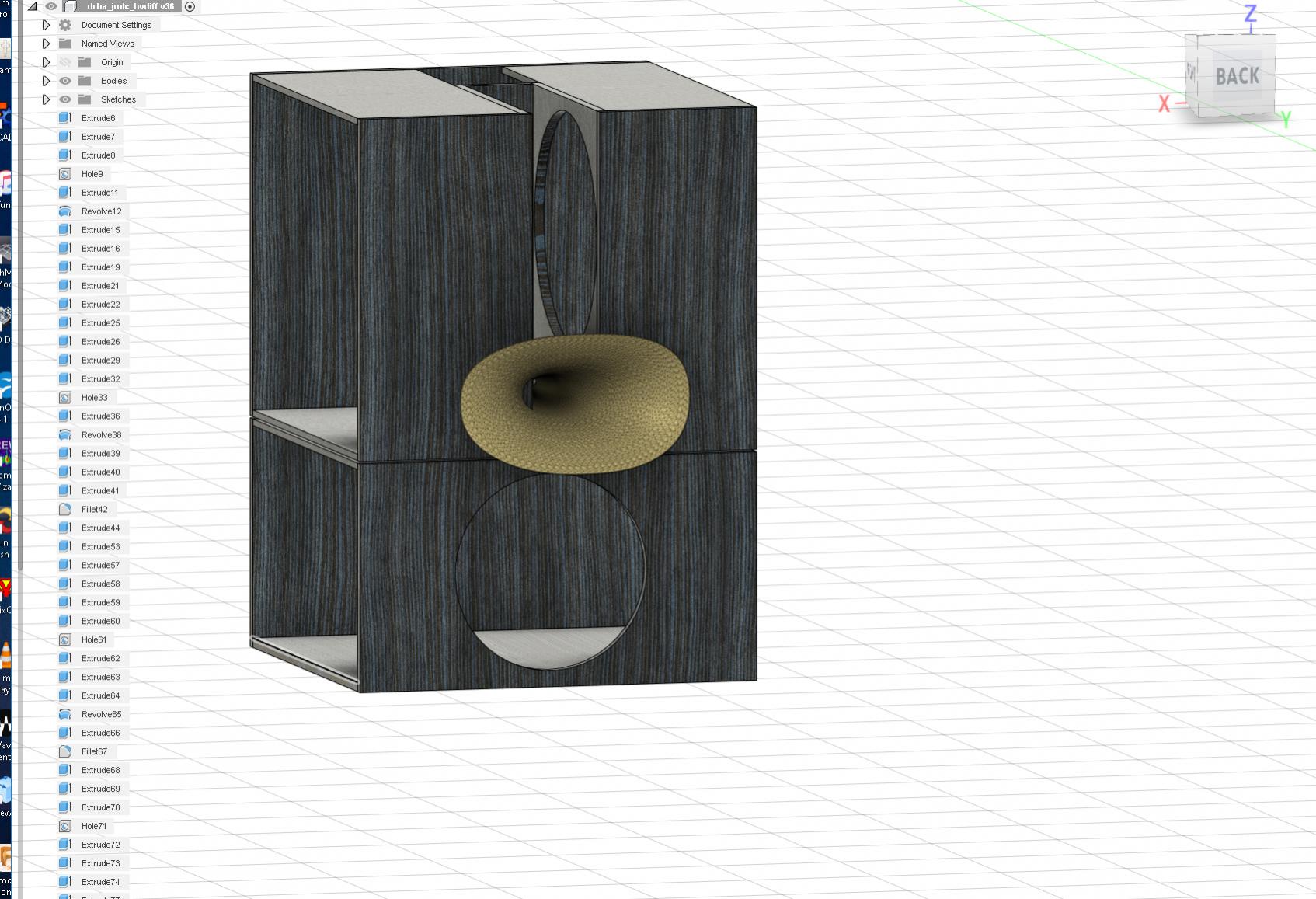 make sense to anyone? In terms of ideal?
make sense to anyone? In terms of ideal?
The measurements at the mouth are the most intimate, no? so if any resonances were to be recorded, this is a great place to inspect, correct? The measurements look pretty good to me...I did not see any one make a comment so I guess I will speak on it. The spectral decay being comparable if not better than the SM75-150....I get excited.
I have not really gotten intimate with the combo, but I do believe I have found the xmax or close to it....this is why I posted the quote about titanium the other day, lol...and no I did not here any clacky sounds....the sweeps were done with kid noise in the back ground, I don't know if that would throw my thd readings off but...
Thats at ~ 1meter (with eq), I was holding the mic lol, but I did measure the distance...Funny story about the voicing...I don't recall measuring without eq at 1 meter, so the (uneq'd) curve is actually a lot closer to flat at 1 meter...which describes why what I was hearing sound so flat.....yet the measurements at the mouth...I'm sure you get it...thats definitely a rookie mistake, laugh at my expense 🙄...So my first attempt at eq, i let REW do to its thing just see what would happen...but that was a no go...but eqing it the way I would of thought first .....with one low pass shelf... I can pretty much get it going in the right direction...
I made a crappy model of the horn again, but closer to the real thing, this time I used a 2" source with a baffle that was the rectangle size of my horn....so theoretically speaking my horn, in real life, might have some similar polar? probably not close at all but better than the last model lol!!
Finally does this
Attachments
Last edited:
Sorry, I haven't read the whole thread, but here's my 2-way that fits the topic quite well. The drivers are LaVoce WSF152.50 and Tymphany DFM2535
Attachments
Last edited:
Pretty much what I went for, except, turn your woofer side ways and set it on top of a sub box....
I found giant protractors, if anyone needed such a thing...
Giant Protractor Floor Cling & Class Set | Oriental Trading
I found giant protractors, if anyone needed such a thing...
Giant Protractor Floor Cling & Class Set | Oriental Trading
Sorry, I haven't read the whole thread, but here's my 2-way that fits the topic quite well. The drivers are LaVoce WSF152.50 and Tymphany DFM2535
Hi Rese,
Nice two ways!
What internal volume did your cabs end up at and are these ported or sealed?
Thanks.
Sorry, I haven't read the whole thread, but here's my 2-way that fits the topic quite well. The drivers are LaVoce WSF152.50 and Tymphany DFM2535
Very nice speakers with color matched furnitures. Why you crossed them @1.5k? You could make it a bit lower than that if you want to, I guess...
Scored a win on some (used) crown CTS 2000 with USP4 cards in them....since I already have 4 crown crown cts amps as it is...I can swap out the cleanest amps and keep the usp4 cards and sell the rest......every crown cts 2000 listing has several watchers (on ebay) plus I'll be selling them with usp3 cards expecting about the same price I bought them for or a little less, still coming out ahead with legit pro sound FIR/IR filtering on my amp.....wtf is a brickwall crossover? 96db/oct? in FIR it does "brickwall", 48, and 24, xo....thats enough for me...I can do whatever else with Acourate it seems?
Did I really read that Acourate will set up the XO for you? Can you use Acourate to execute the filters and send them to outputs now?
Did I really read that Acourate will set up the XO for you? Can you use Acourate to execute the filters and send them to outputs now?
Last edited:
Yes Acourate can create crossover filters, I don't know if you could use it in a useful way with a tap limited hardware device. It is designed to be used through computer convolution. I wouldn't describe 96dB/oct as a brickwall filter but crown might in marketing terms.
Lab gruppen idp series can do FIR filters via firmware up date.... FYI
Fluid my personal dsp advisor lol ty do much replying (as I hoped you would lol)
So is there any benefit I might consider of linear phase outside of crossover?
Does Acourate calculate cover points?
With the usp4 linear phase xover...plus minimum phase voicing....plus linear phase convolution (Acourate + ????) sounds like a done deal?
Fluid my personal dsp advisor lol ty do much replying (as I hoped you would lol)
So is there any benefit I might consider of linear phase outside of crossover?
Does Acourate calculate cover points?
With the usp4 linear phase xover...plus minimum phase voicing....plus linear phase convolution (Acourate + ????) sounds like a done deal?
Linear phase makes sense for crossovers outside that, the terminology needs to be expanded to properly describe the filter.So is there any benefit I might consider of linear phase outside of crossover?
Linear phase suggests that the phase is flat and the magnitude is what changes.
Minimum phase has the phase following the frequency response.
Sometimes Linear phase as a term is used to describe acausal filters where the phase and magnitude responses can be set completely independently.
There can also be mixed phase where a combination of the two is used in the one filter.
Acourate, Audiolense, DRC, Dirac etc. can generate all of them based on what the user wants or programs in.
So a filter that can vary the magnitude and phase as needed can be very useful if used properly and carefully, but they can also be abused and make things sound terrible.
A straight Linear phase PEQ has more limited use in speaker tuning but for some things they can be the right choice.
I don't believe so but I have never used it, it was my understanding that you selected the crossover frequencies and types as part of the process.Does Acourate calculate cover points?
This document gives an overview and some examples
http://www.acourate.com/freedownload/XOWhitePaper.pdf
If you already had those parts then you could use them that way, Acourate is better used as a complete system where the filters it generates are output to the drivers via hardware or software.With the usp4 linear phase xover...plus minimum phase voicing....plus linear phase convolution (Acourate + ????) sounds like a done deal?
The USP cards have a SHARC DSP so they should be able to load Acourate generated filters but Acourate would be limited in this scenario due to the available taps in the system.
Most DSP hardware comes from the Live sound arena due to there being a market for it there, latency is usually a problem there so high tap counts are of little value. The only realistic option for using Acourate to it's fullest extent is computer convolution.
Having said that you could do a huge amount with the DSP in the USP cards for crossovers and minimum phase corrections without needing to use anything else. That is where I would start.
lets see your measurements, looks like it was falling off at 100hz above.....
These measurements are only valid from around 250Hz upwards, because in normal living rooms with 2.5 m high ceilings you cannot measure deeper without catching the reflections.
The bass can be simulated without any problems, so it is not absolutely necessary to measure it. I also added the simulation.
@Mazza:
The internal volume is about 90 liters (3.17ft³) and it is closed, but with a large high-pass cap, which pushes a little in the bass. In the second simulation you can see what effects this has. Red is closed, black is with a cap. Blue would be a very large BR case, but it doesn't matter here.
@plasnu:
You're right, I could have crossed down to around 900Hz, but the off-axis response of the woofer and horn fits very well at 1.5kHz. I also tried a deeper crossover, but it got worse and would have required more effort for the crossover. And the woofer also does a very good sound up to 1.5 kHz.
Attachments
Is the GHP based on the capacitor being loaded with the real, measured impedance of the woofer in box?
Yes, the capacitor lowers the impedance a little below the impedance peak of the closed box and thus enables higher levels in this area.
Unfortunately I don't have a measurement with and without a cap.
But here is an example of a subwoofer simulation based on the same principle.
Unfortunately I don't have a measurement with and without a cap.
But here is an example of a subwoofer simulation based on the same principle.
Attachments
- Home
- Loudspeakers
- Multi-Way
- Is it possible to cover the whole spectrum, high SPL, low distortion with a 2-way?
